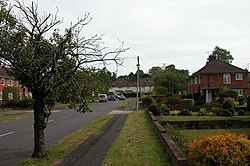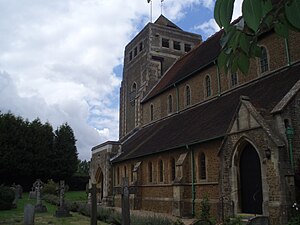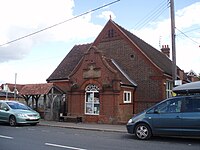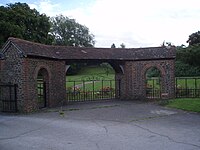Liss
| Liss | |
| Hampshire | |
|---|---|
 Housing estate in Liss | |
| Location | |
| Grid reference: | SU785275 |
| Location: | 51°2’34"N, 0°53’31"W |
| Data | |
| Population: | 6,291 (2011) |
| Post town: | Liss |
| Postcode: | GU33 |
| Dialling code: | 01730 |
| Local Government | |
| Council: | East Hampshire |
| Parliamentary constituency: |
East Hampshire |
Liss (previously spelt Lys or Lyss) is a village in Hampshire, in the east of the county, a mile from the border of Sussex (marked here by the old Portsmouth Road running through Hill Brow half a mile south of the edge of Liss).
The village comprises an old village at West Liss and a modern village round the 19th-century station: the two are divided by the River Rother.[1]
The village is in the South Downs National Park, with forests all about it. Immediately to the north indeed is the village named Liss Forest. It is three miles north-east of Petersfield, and the tearing hurry of the A3 trunk road (the modern Portsmouth Road) runs just west of the village.
Liss has a railway station, on the Portsmouth Direct Line.
Contents
Churches
The parish church, St Peter's, stands in West. It is a stone-built edifice built in the 13th century, replacing an earlier timber structure. The Chancel, parts of tower, and octagonal piers of arcade date from that century. The octagonal font, mullioned and transomed window in south aisle and the distinctive weatherboard top stage of tower are later.
The church in Liss was attached to the church of Odiham which appointed the curate-in-charge and remained so until 1867.
St Mary's Church was built in 1892–94 to the design of Arthur Blomfield, to serve the new parts of the village, replacing St Peter at West Liss, which remains an intact 13th-century structure with its few later additions. The original construction of St Mary's consisted of a chancel with a north transept for the organ and a vestry, and a nave with north and south aisles and a north porch in plain 13th-century style. It is built of local sandstone with dressed quoins, with brick lining.[citation needed]
The tower of St Mary's was added in 1932 – again from local sandstone – and it became the Parish Church in 1959. In the 1940s and 1950 it was often described locally and unflatteringly as "the Stump".
In 1911, an iron mission hall is recorded at Hill Brow with a Wesleyan chapel at East Liss, and for Plymouth Brethren a meeting-house at West Liss.
History and heritage
Earliest times
Flint spearheads, arrowheads, scrapers, flakes and cores dating from Palaeolithic and Mesolithic times have been found,[2] and Neolithic axe heads and flint implements.
From the Bronze Age there is an Irish decorated axe and bracelets, and there are plentiful Bronze Age features on the chalk hangers above the village, and bowl barrows in the landscape. Traces of human and animal hair were found in a tree trunk coffin burial.
There is evidence of Roman settlement in Liss too.[3]
Middle Ages
In the late 9th century, King Alfred the Great created an Abbey at Lyss Place under the control of St Mary's Abbey at Winchester as a retreat for nuns. Local historians indicate their belief that St Peter's Church has Saxon footings, and that the remaining plan reflects an earlier Saxon Church on the site. However no fabric is evident [4]
In the Domesday Book of 1086, Liss is recorded as Lyss or Lis, in the Meonstoke of Hampshire.[5] It notes that in the time of Edward the Confessor (1042–1066), there was a mill in operation at Liss paying an annual rent.
The manor of Liss was later known as 'Liss Abbess', and the Abbess and nuns of Winchester held it until the dissolution of the monasteries in 1538. Thereafter it was Crown property until about 1610
Modernity
In about 1610, the manor and its former monastic house, Lyss Place, passed into private ownership and was subsequently held variously by the Cole, Fitzpatrick, Taylor and Hawkshaw families.
Liss remained primarily an agricultural village in an open setting, but became known in the 19th century for the production of peppermint, an industry sponsored by the Money family of Stodham Park. The mint was grown, distilled and sold at 4d a pint.
The enclosure of the commons and wastelands was carried out in 1864. Within the Inclosure Award, the West Liss Recreation Ground, the four allotments sites "for the labouring poor of the parish" and a number of roads were created.
The village was radically altered in 19th century, essentially being moved eastwards by new developments. The newer centre is late Victorian in character. The Southern Railway came from the North East to East Liss (and then along the Rother Valley towards Portsmouth) in 1859. East Liss became the Village of Liss.
Military railway
In 1933 a military railway known as the Longmoor Military Railway was built from Liss Station to the Longmoor Military Camp. This caused a further increase in population. The railway was used as a set for many films including The Great St Trinian's Train Robbery and Chitty Chitty Bang Bang.
In light of the reducing role of the Army in the 1960s, the Ministry of Defence closed the railway. This caused a local fuss and fundraising to purchase at least some of the line. A proposal to establish a railway museum foundered, but the Army offered to hand over the last 1½ miles of line from Liss Forest Road to Liss. Three items of rolling stock (a van, a brake van, and a bogie flat) still remain on the Longmoor site as part of the FIBUA training village.
Twentieth and twenty-first centuries
Immediately after Second World War, local authority housing was built in East Liss under the William Beveridge programmes. Since the mid-1960s, a number of large new estates have extended the village and increased its population. The 1965 Harcos development at Patrick's Copse and Greenfields etc. has been extended several times since the 1970s to cover existing landscaped open ground and traditional marshland.
In the 1980s new red brick shopping areas and housing have extended the centre of the village where rough grazing for horses previously existed, and added a new supermarket unit, other shops and office space.
The construction of the Petersfield & Liphook bypass (A3 road) as a four-lane limited-access dual carriageway past West Liss, has removed much through traffic from the centres of Petersfield and Liphook.
The population of Liss is approximately 6,000. Commuters form a large proportion of residents. Liss is served by Liss railway station.
About the village
Stodham Park House was built about 1820 as part of the Money family estate. It has three storeys and a basement with an imposing four-pillared porch with steps to the main door. Clara Maria Burdett, apparently tracing her family to the Norman Conquest, married into the Money-Coutts of Stodham Park and lived at the house until her death in 1899. The family donated the existing Village Hall.
The village stocks stood on the green, near an ancient oak. The oak is now entirely hollow, and remains in front of the current Spread Eagle Inn.
A traditional fair was held in May in the field between the Spread Eagle Inn and Church Street, opposite the glebe meadow where Liss Cricket Club now plays.
Sport and leisure
- Cricket: Liss Cricket Club
- Football: Liss Athletic F.C., which plays at The Newman Collard Playing Fields
- Golf: Petersfield Golf Club, on the site of Tankerdale Farm
- Road running: Liss Runners
- Tennis: The Newman Collard
| ("Wikimedia Commons" has material about Liss) |
References
- ↑ A History of the County of Hampshire - Volume 4 pp 84-86: Parishes: Liss (Victoria County History)
- ↑ Archi UK Retrieved 16 April 2018.
- ↑ "Archaeological group aims to unearth more diggers". Farnham Herald. 2 March 2018. http://www.farnhamherald.com/article.cfm?id=125971&headline=Archaeological%20group%20aims%20to%20unearth%20more%20diggers§ionIs=news&searchyear=2018.
- ↑ "Anglo Saxon Architecture". Seminal Work Widely Acclaimed when It First Appeared in 1978 (Cambridge University Press).
- ↑ Liss in the Domesday Book



